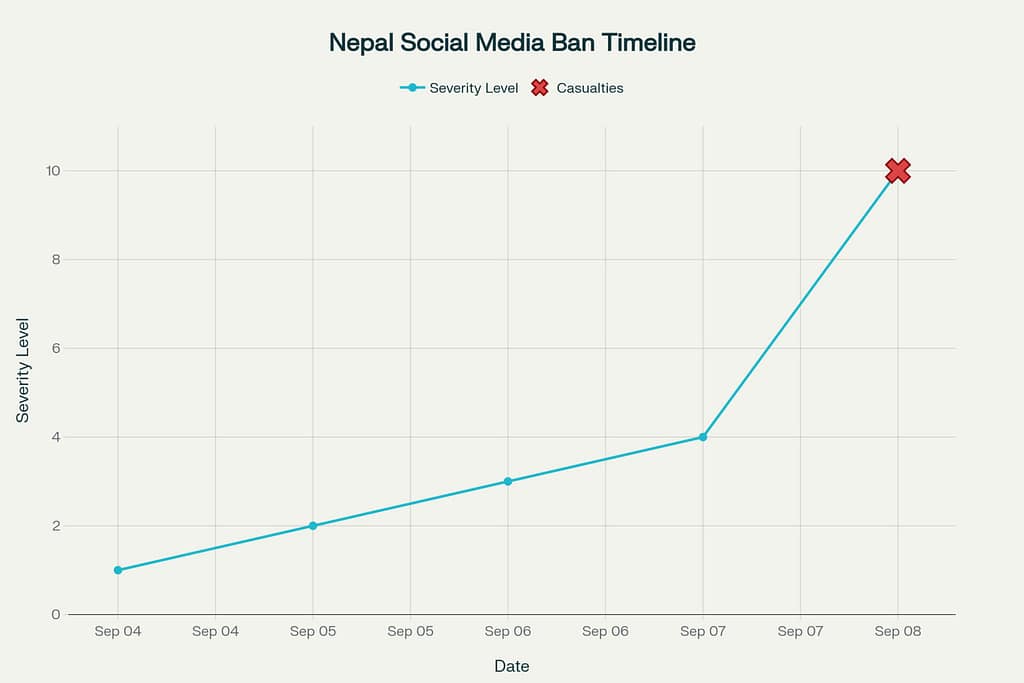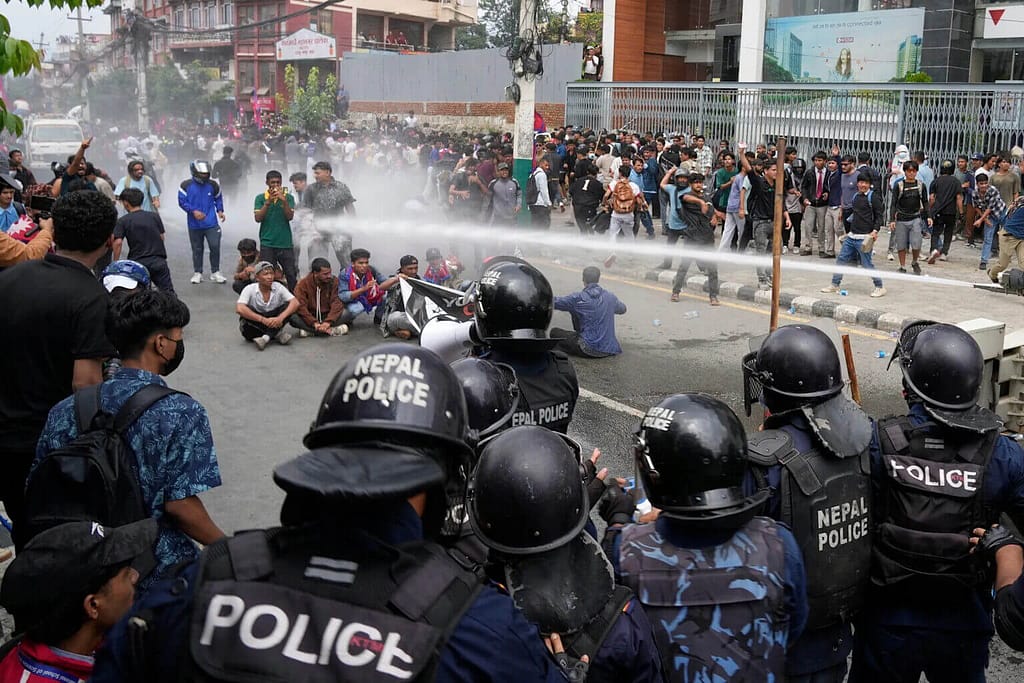
Protesters confront Nepal police as social media ban triggers public unrest

The streets of Kathmandu turned into a battlefield on September 8, 2025, when peaceful Gen Z protesters demanding an end to Nepal’s social media ban faced deadly police violence that left 19 demonstrators dead and over 200 injured. In shocking eyewitness accounts, protesters described how Nepal police shooting protesters in head became a horrific reality as officers opened fire with live ammunition on young demonstrators who had gathered to protest government corruption and the controversial social media blackout.
The Spark That Ignited Nepal’s Deadly Protests
Government’s Controversial Social Media Ban
On September 4, 2025, Nepal’s government implemented a sweeping ban on 26 major social media platforms, including Facebook, Instagram, WhatsApp, YouTube, and X (formerly Twitter). The ban targeted platforms that failed to register with Nepal’s Ministry of Communications and Information Technology under the 2023 Social Media Directive.
The government justified the ban by citing concerns over misinformation, hate speech, cybercrime, and fake accounts. However, the decision immediately sparked outrage among Nepal’s digitally-connected population, where over 90% of the country’s 30 million people use the internet.

The Human Cost of Digital Censorship
The social media ban severely disrupted daily life for millions of Nepalis who rely on these platforms for communication, business, and staying connected with family members working abroad. With Nepal’s personal remittances estimated at 33.06% of GDP according to World Bank data, the communication blackout particularly affected families dependent on overseas workers.

When Peaceful Protest Met Police Brutality
Gen Z Takes to the Streets
What began as a peaceful demonstration organized by Nepal’s Gen Z movement quickly escalated into the country’s deadliest unrest in years. Thousands of young protesters, many wearing school and college uniforms, gathered at Maitighar in Kathmandu on Monday morning, September 8, 2025.
The protesters chanted slogans like “Stop the ban on social media, stop corruption not social media” while waving Nepal’s red and blue national flags. Their demands extended beyond the social media ban to address broader issues of government corruption and authoritarian rule.

The Horrific Moment: “Police Shot Friend in the Head”
The situation turned deadly when protesters attempted to breach police barricades around the Parliament building. In a chilling eyewitness account that became the rallying cry of the movement, one protester told ANI news agency:
“A while ago, the police fired bullets which did not hit me but hit a friend of mine standing behind me. He was shot in the hand. The firing is still going on and we can hear gunfire from inside the parliament as well. My friend, who was standing on the road, was shot in the head. The police are firing indiscriminately, aiming above the knees. Are they allowed to do this?”
This harrowing testimony became symbolic of the Nepal police shooting protesters in head incident that shocked the international community.

Overwhelming Medical Crisis
Dr. Badri Risal from the National Trauma Centre, Nepal’s main hospital, described the horrific injuries: “Many of them are in serious condition and appear to have been shot in the head and chest”. The hospital received seven fatalities and 58 wounded patients, with emergency wards overwhelmed by the casualties.
Hospitals across Kathmandu struggled to handle the massive influx of patients:
- National Trauma Centre: 8 deaths, 59 injured
- Civil Hospital: 3 deaths, 100 injured
- Everest Hospital: 3 deaths, 102 injured
- Kathmandu Medical College: 2 deaths, 37 injured
- Tribhuvan Teaching Hospital: 1 death, 18 injured
Government’s Iron Fist Response
Military Deployment and Curfews
As protests spread beyond Kathmandu to cities including Pokhara, Biratnagar, and Butwal, Prime Minister KP Sharma Oli’s government responded with overwhelming force. The Nepal Army was deployed to control the situation, while curfews were imposed across multiple cities.
The Kathmandu District Administration Office extended curfew orders to cover sensitive government areas including the President’s residence, Prime Minister’s office, and Parliament complex.
Police Tactics and Weapons Used
Nepal police employed a range of crowd control weapons that proved deadly:
- Live ammunition – resulting in fatal head and chest wounds
- Rubber bullets – causing serious injuries
- Tear gas canisters – deployed extensively
- Water cannons – used to disperse crowds
- Baton charges – against protesters who breached barricades
Youth protesters hold a flag and rally on barricades during a Nepal street demonstration under an overcast sky
The Broader Context: Why Nepal’s Youth Rose Up
More Than Just Social Media
While the social media ban triggered the protests, demonstrators made clear their grievances ran deeper. As 24-year-old student Yujan Rajbhandari told AFP: “We were triggered by the social media ban, but that is not the only reason we are gathered here. We are protesting against corruption that has been institutionalised in Nepal”.
The protests reflected growing frustration among Nepal’s youth with:
- Systemic corruption in government institutions
- Authoritarian governance under PM KP Sharma Oli
- Economic stagnation and lack of opportunities
- Digital rights violations and censorship
International Condemnation
Human rights organizations strongly condemned the government’s response. Amnesty International’s Nepal Director Nirajan Thapaliya stated: “Amnesty International strongly condemns the unlawful use of lethal and less-lethal force by law enforcement in Nepal, resulting in deaths and serious injuries of several protesters”.
The Committee to Protect Journalists and Federation of Nepali Journalists also criticized the social media ban as undermining press freedom and democratic access to information.
People Also Ask (PAA)
Q: How many people died in the Nepal protests on September 8, 2025?
A: At least 19 people died during the Nepal protests on September 8, 2025, with over 200 injured. Most deaths occurred in Kathmandu, with additional casualties in Itahari and other cities.
Q: Why did Nepal ban social media platforms?
A: Nepal banned 26 social media platforms on September 4, 2025, because companies like Meta (Facebook, Instagram), Google (YouTube), and X failed to register with Nepal’s government under the 2023 Social Media Directive.
Q: What did the eyewitness say about police shooting protesters?
A: An eyewitness told ANI that police “fired bullets which did not hit me but hit a friend of mine standing behind me” and that his “friend, who was standing on the road, was shot in the head”.
Q: Which hospitals treated the wounded protesters in Nepal?
A: Major hospitals treating wounded protesters included National Trauma Centre (8 deaths), Civil Hospital (3 deaths), Everest Hospital (3 deaths), and Kathmandu Medical College (2 deaths).
Q: What was the government’s response to the deadly protests?
A: The government deployed the Nepal Army, imposed curfews in multiple cities, and PM KP Sharma Oli called an emergency cabinet meeting. The Home Minister later resigned taking “moral responsibility”.
The Aftermath and Political Fallout
Government Under Pressure
Facing intense criticism over the deadly crackdown, Nepal’s government began showing signs of backing down. Communications Minister Prithvi Subba Gurung indicated that discussions were underway to reconsider the social media ban, stating: “The government’s decisions are not more important than the lives of the people”.
The Home Minister resigned, taking “moral responsibility” for the violence, while opposition parties called for Prime Minister Oli’s resignation.
International Scrutiny
The Nepal police shooting protesters head incident drew international attention to the country’s deteriorating human rights situation. The violence highlighted concerns about democratic backsliding under PM Oli’s administration and the government’s increasing intolerance of dissent.
Lessons from a Digital Rights Tragedy
The deadly Nepal protests of September 8, 2025, serve as a stark warning about the dangers of digital authoritarianism and heavy-handed responses to peaceful protest. What began as a social media ban escalated into a human rights crisis that claimed 19 young lives and injured hundreds more.
The tragic testimony of protesters watching their friends shot in the head by police will likely become a defining moment in Nepal’s struggle for digital rights and democratic governance. As the international community continues to monitor the situation, the question remains whether Nepal’s government will learn from this tragedy or continue down a path of increasing authoritarianism.
The courage of Nepal’s Gen Z protesters, who stood up against both digital censorship and systemic corruption despite facing deadly force, represents a powerful reminder that the fight for freedom and democracy often comes at the highest cost.
Read this also: https://trendingnowindia.in/nepal-social-media-ban/






Looks like the protests in Nepal are gaining huge attention right now. The people seem really determined to raise their voices, and the government’s response will be crucial in shaping what comes next. ✊🇳🇵 #NepalProtests #VoiceOfThePeople